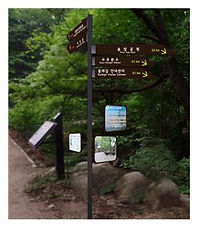An analysis on the universal design application to the Bukhansan national park sign facilities
Seo Dong-ik
Seoul National University of Science and Technology NID Graduate School
Ko Young-jun
Seoul National University of Science and Technology
Background
Since the barrier-free trail of Bukhansan Dulegil surrounding the foot of Bukhansan National Park is adjacent to the urban area, it is a place where a variety of people enjoy visiting, including children, elderly people and even stroller users. Despite such an advantage, it is not easy for some people to approach this area since the trail was not designed based on the concept of universal design. Thus, this study aims to help all the people easily use guide signs along the barrier-free trail around Bukhansan National Park Dulegil.
Methods
To investigate the universal design of guide signs around Bukhansan National Park Dulegil, this study was conducted in the following three methods.
Firstly, this study investigated the characteristics of Bukhansan National Park and visitors' use behaviors and analyzed the present states and problems about guide signs around Bukhansan National Park Dulegil. Secondly, based on '5 Principles of Universal Sign' and 'UD Evaluation of Public Environments' out of all the previous researches, this study established evaluation standards applicable to Bukhansan National Park and evaluated whether the universal design could be applied through a survey research on visitors to Bukhansan National Park. Thirdly, through a group interview composed of public design experts and an investigation into field actual conditions with wheelchair users, this study comprehended various users' demands and drew a right direction for the design of guide signs around Bukhansan National Park in terms of universal design.
Results
As a result of carrying out an evaluation on the applicability of universal design used for guide signs around Bukhansan National Park Dulegil, this study found out that the applicability of universal design was highest in attractiveness, followed by fairness, usability and accessibility in order, while recognition and safety were found to be relatively insufficient. Since the score of attractiveness was highest, visitors seemed to evaluate positively that the present guide signs in Bukhansan National Park are externally in harmony with nature. On the other hand, since the score of safety was lowest, this study could judge that the present guide signs in Bukhansan National Park have failed to provide proper measures or information in case of natural disasters or visitors' accidents. Even from the investigation into field actual conditions with wheelchair users, this study found out there were some problems in the aspect of safety. Based on the results from the evaluation and the investigation into field actual conditions, this study devised a new arrangement and design of guide signs with the concept of universal design applied.
Conclusion
For an efficient arrangement of guide signs of Bukhansan National Park, it is needed to minimize elements of facilities, and for visitors to understand the space better, it is necessary to categorize information. Besides, to increase the accessibility of the mobility vulnerable, it is required to differentiate the location of guide signs by type, and to increase the safety, it is needed to apply lighting and electronic displays to guide signs, or to establish a system for users to acquire additional information through their smart phones or QR codes. Then, all the visitors in various different circumstances are able to use Dulegil or the trail in Bukhansan National Park as equally as other ordinary people do.


Survey of Gangnam Mediapole Application of Universal Design

